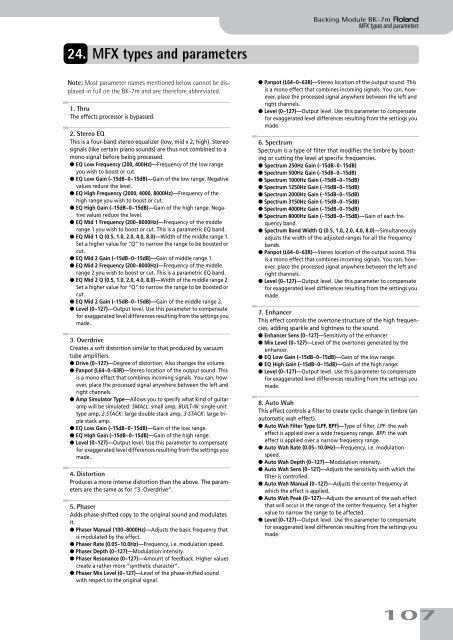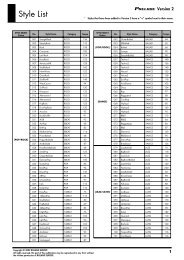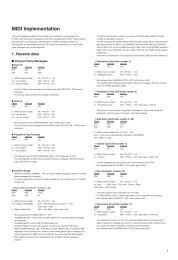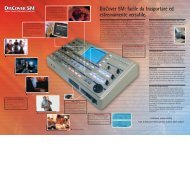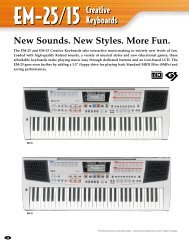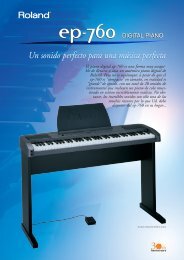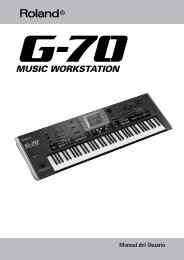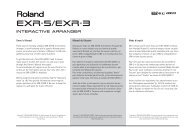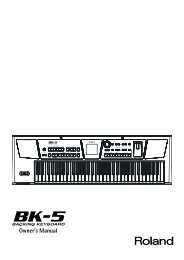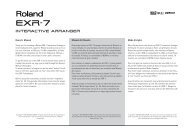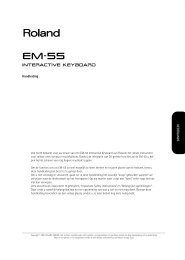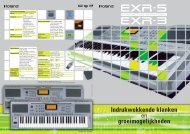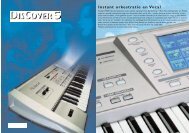BK-7m_OM.pdf - Roland
BK-7m_OM.pdf - Roland
BK-7m_OM.pdf - Roland
You also want an ePaper? Increase the reach of your titles
YUMPU automatically turns print PDFs into web optimized ePapers that Google loves.
Backing Module <strong>BK</strong>-<strong>7m</strong> r<br />
MFX types and parameters<br />
24. MFX types and parameters<br />
Note: Most parameter names mentioned below cannot be displayed<br />
in full on the <strong>BK</strong>-<strong>7m</strong> and are therefore abbreviated.<br />
1. Thru<br />
The effects processor is bypassed.<br />
2. Stereo EQ<br />
This is a four-band stereo equalizer (low, mid x 2, high). Stereo<br />
signals (like certain piano sounds) are thus not combined to a<br />
mono signal before being processed.<br />
● EQ Low Frequency (200, 400Hz)—Frequency of the low range<br />
you wish to boost or cut.<br />
● EQ Low Gain (–15dB~0~15dB)—Gain of the low range. Negative<br />
values reduce the level.<br />
● EQ High Frequency (2000, 4000, 8000Hz)—Frequency of the<br />
high range you wish to boost or cut.<br />
● EQ High Gain (–15dB~0~15dB)—Gain of the high range. Negative<br />
values reduce the level.<br />
● EQ Mid 1 Frequency (200~8000Hz)—Frequency of the middle<br />
range 1 you wish to boost or cut. This is a parametric EQ band.<br />
● EQ Mid 1 Q (0.5, 1.0, 2.0, 4.0, 8.0)—Width of the middle range 1.<br />
Set a higher value for “Q” to narrow the range to be boosted or<br />
cut.<br />
● EQ Mid 2 Gain (–15dB~0~15dB)—Gain of middle range 1.<br />
● EQ Mid 2 Frequency (200~8000Hz)—Frequency of the middle<br />
range 2 you wish to boost or cut. This is a parametric EQ band.<br />
● EQ Mid 2 Q (0.5, 1.0, 2.0, 4.0, 8.0)—Width of the middle range 2.<br />
Set a higher value for “Q” to narrow the range to be boosted or<br />
cut.<br />
● EQ Mid 2 Gain (–15dB~0~15dB)—Gain of the middle range 2.<br />
● Level (0~127)—Output level. Use this parameter to compensate<br />
for exaggerated level differences resulting from the settings you<br />
made.<br />
3. Overdrive<br />
Creates a soft distortion similar to that produced by vacuum<br />
tube amplifiers.<br />
● Drive (0~127)—Degree of distortion. Also changes the volume.<br />
● Panpot (L64~0~63R)—Stereo location of the output sound. This<br />
is a mono effect that combines incoming signals. You can, however,<br />
place the processed signal anywhere between the left and<br />
right channels.<br />
● Amp Simulator Type—Allows you to specify what kind of guitar<br />
amp will be simulated: SMALL: small amp, BUILT-IN: single-unit<br />
type amp, 2-STACK: large double stack amp, 3-STACK: large triple<br />
stack amp.<br />
● EQ Low Gain (–15dB~0~15dB)—Gain of the low range.<br />
● EQ High Gain (–15dB~0~15dB)—Gain of the high range.<br />
● Level (0~127)—Output level. Use this parameter to compensate<br />
for exaggerated level differences resulting from the settings you<br />
made.<br />
4. Distortion<br />
Produces a more intense distortion than the above. The parameters<br />
are the same as for “3. Overdrive”.<br />
5. Phaser<br />
Adds phase-shifted copy to the original sound and modulates<br />
it.<br />
● Phaser Manual (100~8000Hz)—Adjusts the basic frequency that<br />
is modulated by the effect.<br />
● Phaser Rate (0.05~10.0Hz)—Frequency, i.e. modulation speed.<br />
● Phaser Depth (0~127)—Modulation intensity.<br />
● Phaser Resonance (0~127)—Amount of feedback. Higher values<br />
create a rather more “synthetic character”.<br />
● Phaser Mix Level (0~127)—Level of the phase-shifted sound<br />
with respect to the original signal.<br />
● Panpot (L64~0~63R)—Stereo location of the output sound. This<br />
is a mono effect that combines incoming signals. You can, however,<br />
place the processed signal anywhere between the left and<br />
right channels.<br />
● Level (0~127)—Output level. Use this parameter to compensate<br />
for exaggerated level differences resulting from the settings you<br />
made.<br />
6. Spectrum<br />
Spectrum is a type of filter that modifies the timbre by boosting<br />
or cutting the level at specific frequencies.<br />
● Spectrum 250Hz Gain (–15dB~0~15dB)<br />
● Spectrum 500Hz Gain (–15dB~0~15dB)<br />
● Spectrum 1000Hz Gain (–15dB~0~15dB)<br />
● Spectrum 1250Hz Gain (–15dB~0~15dB)<br />
● Spectrum 2000Hz Gain (–15dB~0~15dB)<br />
● Spectrum 3150Hz Gain (–15dB~0~15dB)<br />
● Spectrum 4000Hz Gain (–15dB~0~15dB)<br />
● Spectrum 8000Hz Gain (–15dB~0~15dB)—Gain of each frequency<br />
band.<br />
● Spectrum Band Width Q (0.5, 1.0, 2.0, 4.0, 8.0)—Simultaneously<br />
adjusts the width of the adjusted ranges for all the frequency<br />
bands.<br />
● Panpot (L64~0~63R)—Stereo location of the output sound. This<br />
is a mono effect that combines incoming signals. You can, however,<br />
place the processed signal anywhere between the left and<br />
right channels.<br />
● Level (0~127)—Output level. Use this parameter to compensate<br />
for exaggerated level differences resulting from the settings you<br />
made.<br />
7. Enhancer<br />
This effect controls the overtone structure of the high frequencies,<br />
adding sparkle and tightness to the sound.<br />
● Enhancer Sens (0~127)—Sensitivity of the enhancer.<br />
● Mix Level (0~127)—Level of the overtones generated by the<br />
enhancer.<br />
● EQ Low Gain (–15dB~0~15dB)—Gain of the low range.<br />
● EQ High Gain (–15dB~0~15dB)—Gain of the high range.<br />
● Level (0~127)—Output level. Use this parameter to compensate<br />
for exaggerated level differences resulting from the settings you<br />
made.<br />
8. Auto Wah<br />
This effect controls a filter to create cyclic change in timbre (an<br />
automatic wah effect).<br />
● Auto Wah Filter Type (LPF, BPF)—Type of filter. LPF: the wah<br />
effect is applied over a wide frequency range. BPF: the wah<br />
effect is applied over a narrow frequency range.<br />
● Auto Wah Rate (0.05~10.0Hz)—Frequency, i.e. modulation<br />
speed.<br />
● Auto Wah Depth (0~127)—Modulation intensity.<br />
● Auto Wah Sens (0~127)—Adjusts the sensitivity with which the<br />
filter is controlled.<br />
● Auto Wah Manual (0~127)—Adjusts the center frequency at<br />
which the effect is applied.<br />
● Auto Wah Peak (0~127)—Adjusts the amount of the wah effect<br />
that will occur in the range of the center frequency. Set a higher<br />
value to narrow the range to be affected.<br />
● Level (0~127)—Output level. Use this parameter to compensate<br />
for exaggerated level differences resulting from the settings you<br />
made.<br />
107


